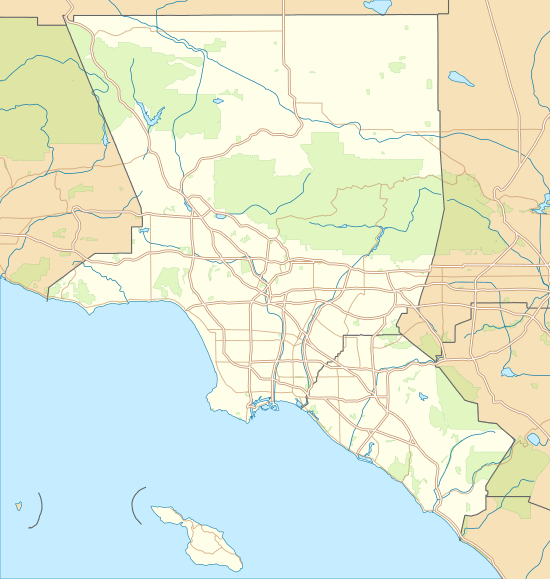Canyon Country, Santa Clarita, California
Canyon Country is a community and district within the city of Santa Clarita, located in northwestern Los Angeles County, California, United States.
Canyon Country | |
|---|---|
Neighborhood of Santa Clarita | |
A neighborhood in the Sierra Pelona Mountains, in Canyon Country near the central Sand Canyon and Soledad Canyon Roads junction with the San Gabriel Mountains in the background. | |
 Canyon Country Position in Los Angeles County. | |
| Coordinates: 34°25′24″N 118°28′17″W | |
| Country | |
| State | |
| County | Los Angeles |
| City | Santa Clarita |
| Elevation | 466 m (1,529 ft) |
| Population (2010) | |
| • Total | 59,530 |
| Time zone | UTC-8 (Pacific (PST)) |
| • Summer (DST) | UTC-7 (PDT) |
| ZIP Code | 91351, 91387 |
| Area code(s) | 661 |
| GNIS feature ID | 2583151 |
| Website | http://www.santa-clarita.com/ |
| U.S. Geological Survey Geographic Names Information System: Canyon Country, Santa Clarita, California | |
Canyon Country is north of the San Fernando Valley via Newhall Pass through the Santa Susana and San Gabriel Mountains. Canyon Country is located in the upper watershed of the Santa Clara River in the Santa Clarita Valley and Sierra Pelona Mountains foothills.
History
The area was the ancestral homeland of the Tataviam people for over five hundred years, and other tribes before then, such as the Tongva, Kitanemuk, and Serrano people. After the Spanish invasion, the valley first became grazing lands of the Mission San Fernando Rey de España around 1790. In 1834, after Mexican Independence, it became part of the Rancho San Francisco land grant centered on the confluence of the Santa Clara River and Castaic Creek.[2]
In the 1880s the rancho become the Newhall Ranch empire of Henry Newhall, now the present day Newhall Land and Farming Company. In 1928 the St. Francis Dam collapsed, suddenly flooding and washing away settlements and people along the Santa Clara River section of present-day Santa Clarita not including Canyon Country. Canyon Country was originally to be called Solemint. It later absorbed the community to the west called Honby. In the 1960s and 1970s the Newhall Land company's suburban developments transformed Canyon Country and the surrounding towns into a focused residential and cultural city.[2]
The house of The Crandall family used in the movie Don't Tell Mom the Babysitter's Dead is located in this community.[3] A home here was also featured in the climax of Real Genius, but it no longer exists.[4]
Santa Clarita founding
In 1987, Canyon Country was one of four communities, with Valencia, Newhall, and Saugus, that merged to create the city of Santa Clarita, California. The latitude of Canyon Country is 34.423N and the longitude is -118.471W.[5] Canyon Country has a population of 59,530 people.
Canyon Country is home to the Placerita Canyon Nature Center, which is also the site of California's original gold discovery at the historic "Oak of the Golden Dream" in 1842.[6]
Services
The Los Angeles County Fire Department Station 104 (Quint), Station 123 (Sand Canyon), and Station 132 (Canyon Country) serve this community.
Demographics
According to a statistical study done on the racial demographics of Santa Clarita, in 2005-2009: 28.2% of the population was hispanic. Another study done in 2005-2009 found that the average asian population was 11,845; 36% of the population was Filipino. 3.8% of the population between 2005-2009 was black and 76.4% was white. Another study done between 2005-2009 showed that 28% of the population was under the age 18, and 30% ages between 25 and 44.[7]
Safety
In 2017, the city was named as one of the top 100 safest cities in America. It ranked third as the safest city in America with a population of about 210,000. The city says the cause for this ranking is due to the law enforcement that the city takes pride in.[8]
Fires
Due to the location which the city is in and its environment, Canyon Country has been susceptible to many fires over the years. Most notably, the Sand Fire (2016). The Sand Fire took place in the east side of the valley and destroyed nearly 42,000 acres of land. The Buckweed Fire (2007) also had an impact on Santa Clarita valley residents. The Buckweed fire destroyed nearly 38,000 acres throughout both Canyon Country and the Santa Clarita Valley.[9]
See also
- Lang Southern Pacific Station a California Historic Landmark
References
- U.S. Geological Survey Geographic Names Information System: Canyon Country, Santa Clarita, California
- "History of Canyon Country". Santa Clarita Valley Historical Society. Retrieved 2004-07-04.
- Iamnotastalker.com
- Ryan, Kyle (April 21, 2010). "Random Roles: William Atherton". The Onion A.V. Club. Retrieved April 21, 2010.
- Epodunk.com
- Placerita.org, accessed 7/4/2010
- "Population | City of Santa Clarita, CA". www.santa-clarita.com. Retrieved 2018-12-08.
- "City News | City of Santa Clarita, CA". www.santa-clarita.com. Retrieved 2018-12-08.
- Fm 98.1, +khts; Am 1220 (2008-10-22). "One Year Later, Buckweed Fire Still Haunts Memories". Hometown Station | KHTS FM 98.1 & AM 1220. Retrieved 2018-12-08.